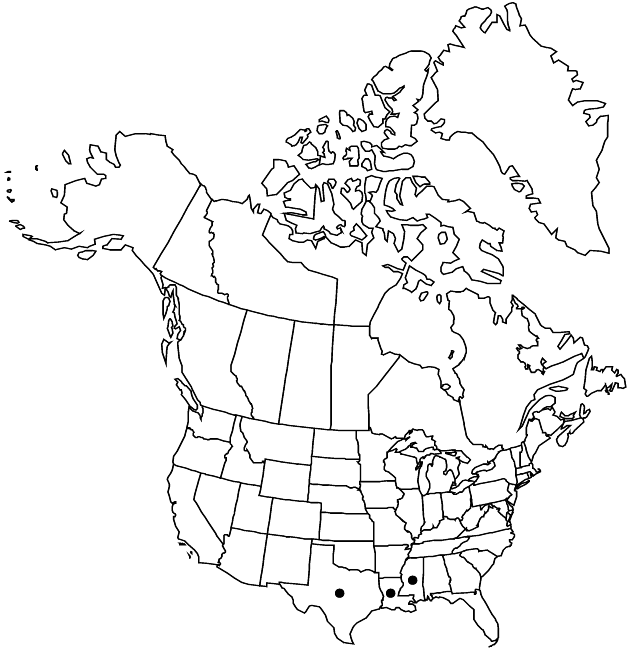Difference between revisions of "Liatris pycnostachya var. lasiophylla"
Field & Lab. 19: 74. 1951.
FNA>Volume Importer |
FNA>Volume Importer |
||
| Line 11: | Line 11: | ||
|name=Lacinaria serotina | |name=Lacinaria serotina | ||
|authority=Greene | |authority=Greene | ||
| + | |rank=species | ||
}} {{Treatment/ID/Synonym | }} {{Treatment/ID/Synonym | ||
|name=Liatris serotina | |name=Liatris serotina | ||
|authority=(Greene) K. Schumann | |authority=(Greene) K. Schumann | ||
| + | |rank=species | ||
}} | }} | ||
|hierarchy=Asteraceae;Asteraceae tribe Eupatorieae;Liatris;Liatris pycnostachya;Liatris pycnostachya var. lasiophylla | |hierarchy=Asteraceae;Asteraceae tribe Eupatorieae;Liatris;Liatris pycnostachya;Liatris pycnostachya var. lasiophylla | ||
| Line 29: | Line 31: | ||
|elevation=0–50 m | |elevation=0–50 m | ||
|distribution=La.;Miss.;Tex. | |distribution=La.;Miss.;Tex. | ||
| − | |discussion=<p>Variety lasiophylla occurs over most of the range of the species in Louisiana and Texas; < | + | |discussion=<p>Variety lasiophylla occurs over most of the range of the species in Louisiana and Texas; <i></i>var.<i> pycnostachya</i> occurs in the northern counties of those states and, apparently, also sporadically southward through the range of <i></i>var.<i> lasiophylla</i>, at least in Texas, where it grows in drier habitats than <i></i>var.<i> lasiophylla</i>. In Louisiana and Texas, <i></i>var.<i> pycnostachya</i> begins flowering in mid-June and continues through July (through August more northward in its range), usually well before the main flowering period of <i></i>var.<i> lasiophylla</i>. Despite these indications of reproductive isolation, apparent intermediates are commonly encountered (usually these are plants with dense cauline vestiture but sparsely pubescent to glabrate leaves, compared to the densely piloso-puberulent stems and leaves of typical <i></i>var.<i> lasiophylla</i>). Most of the plants with reduced vestiture in the range of <i></i>var.<i> lasiophylla</i> also have the later flowering period.</p><!-- |
| − | --><p>In Pearl River and Hancock counties, Mississippi, and St. Tammany and Washington parishes, Louisiana, plants with vestiture of < | + | --><p>In Pearl River and Hancock counties, Mississippi, and St. Tammany and Washington parishes, Louisiana, plants with vestiture of <i></i>var.<i> lasiophylla</i> have phyllaries with rounded to slightly acute apices, different from the rest of the species. These were named <i>Liatris</i> serotina, and it seems likely that they originated as hybrids between <i></i>var.<i> lasiophylla</i> and <i>L. spicata </i>var.<i> resinosa</i>, whose ranges meet in that area. Some plants of <i>L. spicata</i> in Illinois, Indiana, and Minnesota also develop cauline vestiture; the tendency apparently is evolutionarily independent of that in <i></i>var.<i> lasiophylla</i>.</p> |
|tables= | |tables= | ||
|references= | |references= | ||
| Line 39: | Line 41: | ||
-->{{#Taxon: | -->{{#Taxon: | ||
name=Liatris pycnostachya var. lasiophylla | name=Liatris pycnostachya var. lasiophylla | ||
| − | |||
|authority=Shinners | |authority=Shinners | ||
|rank=variety | |rank=variety | ||
| Line 54: | Line 55: | ||
|publication year=1951 | |publication year=1951 | ||
|special status= | |special status= | ||
| − | |source xml=https://jpend@bitbucket.org/aafc-mbb/fna-data-curation.git/src/ | + | |source xml=https://jpend@bitbucket.org/aafc-mbb/fna-data-curation.git/src/eaa6e58056e40c9ef614d8f47aea294977a1a5e9/coarse_grained_fna_xml/V19-20-21/V21_1331.xml |
|tribe=Asteraceae tribe Eupatorieae | |tribe=Asteraceae tribe Eupatorieae | ||
|genus=Liatris | |genus=Liatris | ||
Revision as of 20:34, 16 December 2019
Corms globose, sometimes becoming elongate rhizomes. Stems moderately to densely piloso-puberulent. Leaves moderately to densely piloso-puberulent to nearly glabrous.
Phenology: Flowering mid Jul–Sep(–Nov).
Habitat: Sandy woods, pitcher plant and grass bogs, pine savannas, drainages, roadsides, fencerows, sands, sandy clays, clays
Elevation: 0–50 m
Distribution

La., Miss., Tex.
Discussion
Variety lasiophylla occurs over most of the range of the species in Louisiana and Texas; var. pycnostachya occurs in the northern counties of those states and, apparently, also sporadically southward through the range of var. lasiophylla, at least in Texas, where it grows in drier habitats than var. lasiophylla. In Louisiana and Texas, var. pycnostachya begins flowering in mid-June and continues through July (through August more northward in its range), usually well before the main flowering period of var. lasiophylla. Despite these indications of reproductive isolation, apparent intermediates are commonly encountered (usually these are plants with dense cauline vestiture but sparsely pubescent to glabrate leaves, compared to the densely piloso-puberulent stems and leaves of typical var. lasiophylla). Most of the plants with reduced vestiture in the range of var. lasiophylla also have the later flowering period.
In Pearl River and Hancock counties, Mississippi, and St. Tammany and Washington parishes, Louisiana, plants with vestiture of var. lasiophylla have phyllaries with rounded to slightly acute apices, different from the rest of the species. These were named Liatris serotina, and it seems likely that they originated as hybrids between var. lasiophylla and L. spicata var. resinosa, whose ranges meet in that area. Some plants of L. spicata in Illinois, Indiana, and Minnesota also develop cauline vestiture; the tendency apparently is evolutionarily independent of that in var. lasiophylla.
Selected References
None.